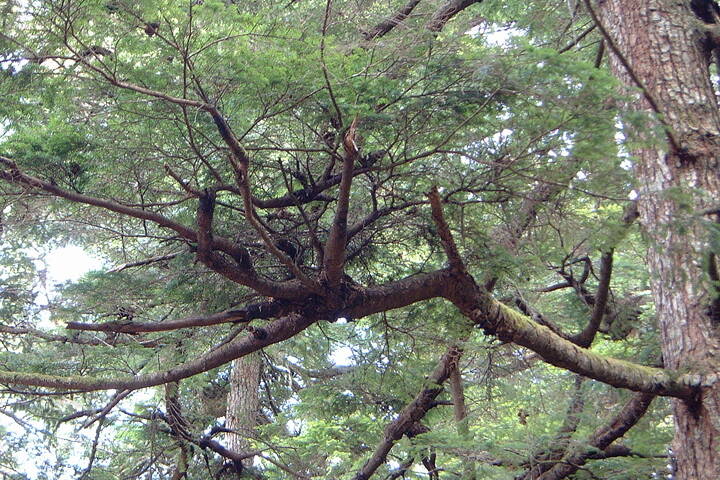Local creatures have often been given the names of early explorers and naturalists that visited our northern shores and forests. So (until the names are changed) we have Townsend’s warblers and Steller’s jays, and so on. Several other species have been attributed to witches. One might wonder if witches too had passed through our forests, leaving tangles of their hair suspended from spruce branches and buttery lumps on dead deciduous wood. And they seem to have lost a lot of their brooms, caught on conifer branches.
Frivolity aside, in the real world the crowded, gnarled bunches of stems and twigs called witch’s brooms are quite common here, usually on hemlock trees. They are caused by a leafless, parasitic flowering plant known as dwarf mistletoe. There are over 20 species of dwarf mistletoe all around the world, parasitizing a variety of trees. The flowers are inconspicuous, pollinated by bees and ants and perhaps other insects. Male and female flowers are on separate plants. The berries are eaten by a variety of birds, which can disperse the seeds, but seeds are also dispersed by explosive expulsion from the fruit, and they are sticky, so they can adhere to other branches.
Other infections can also cause brooms. Certain Taphrina fungi make brooms on birch and cherry trees. A powdery mildew fungus makes brooms on oaks. Mites and viruses also can cause brooms, as well as bacteria-like intracellular parasites called phytoplasmas that cause diseases of deciduous trees, which can lead to broom formation.
The infections that lead to broom formation don’t do the host trees any good, of course — growth and reproduction can be seriously impaired. But animals can make use of the brooms. Spiders and insects find shelter there. Flying squirrels can nest in dwarf mistletoe brooms, and sometimes chickadees and wrens may do so too; marbled murrelets can use those brooms as nesting platforms.
A local photographer found an interesting specimen washed up on a local beach. It was a good-sized giant Pacific chiton, sometimes called a gumboot (although that name is also applied to some other chitons). It was probably moribund. This specimen was maybe about eight inches long, but they are known to reach a length of 14 inches, weighing up to four and a half pounds. They live in the lower intertidal and subtidal zones of the North Pacific, as deep as 20 meters or more, commonly clinging to rocks, but apparently they can be knocked off by heavy wave action. A muscular foot underneath the mantle provides locomotion and rock-clinging ability. They are reported to be able to breathe air, if their gills (between the girdle and the foot) are moist.
This species is the biggest chiton in the world. Its proper name is Cryptochiton stelleri, “crypto” referring to the fact that its hard dorsal plates (or valves) are covered by a leathery girdle or mantle that covers the entire back, so the plates don’t show at all (except in young juveniles). The plates are made mostly of a form of calcium carbonate, not at all like vertebrate bones. The leathery girdle often has a reddish color, due mostly to red algae living on it, although we have sometimes found small specimens that were not that color.
Giant chitons are active mostly at night. They forage on algae, scraping them from rocks with a toothy, tongue-like radula, as well as kelp and sea lettuce. The teeth are extremely hard and sharp, containing a mineral called magnetite, which contains iron oxides. Remarkably, giant chitons are reported to synthesize that mineral, which is usually formed by geological processes. Another iron-containing mineral (santabarabaraite, recently discovered) is said to enclose part of the teeth.
Giant Pacific chitons can live at least 20 years, maybe as much as 40 years. I have not found information about the age at which they reach maturity. They spawn in spring, the females laying strings of eggs that get fertilized by nearby males. The egg strings soon break up and the eggs scatter. When the eggs hatch, the larvae feed on phytoplankton. According to experimental laboratory research (which found results different from some earlier work), larvae keep the larval morphology for variable periods (from a few days to weeks), and then they metamorphose to adults. Rudiments of the dorsal plates begin to appear in late larval stages, only seven of them at first — the eighth one comes a bit later. They start to calcify after metamorphosis.
A number of other critters are reported to live with this chiton as commensals — doing no harm. Polychaete worms (aka bristle worms) and scale worms may live in the mantle groove, and tiny pea crabs may live in the gills. Predators reportedly include sea stars, certain fish, river otters, a snail, and humans.
• Mary F. Willson is a retired professor of ecology. “On The Trails” appears every Wednesday in the Juneau Empire.

